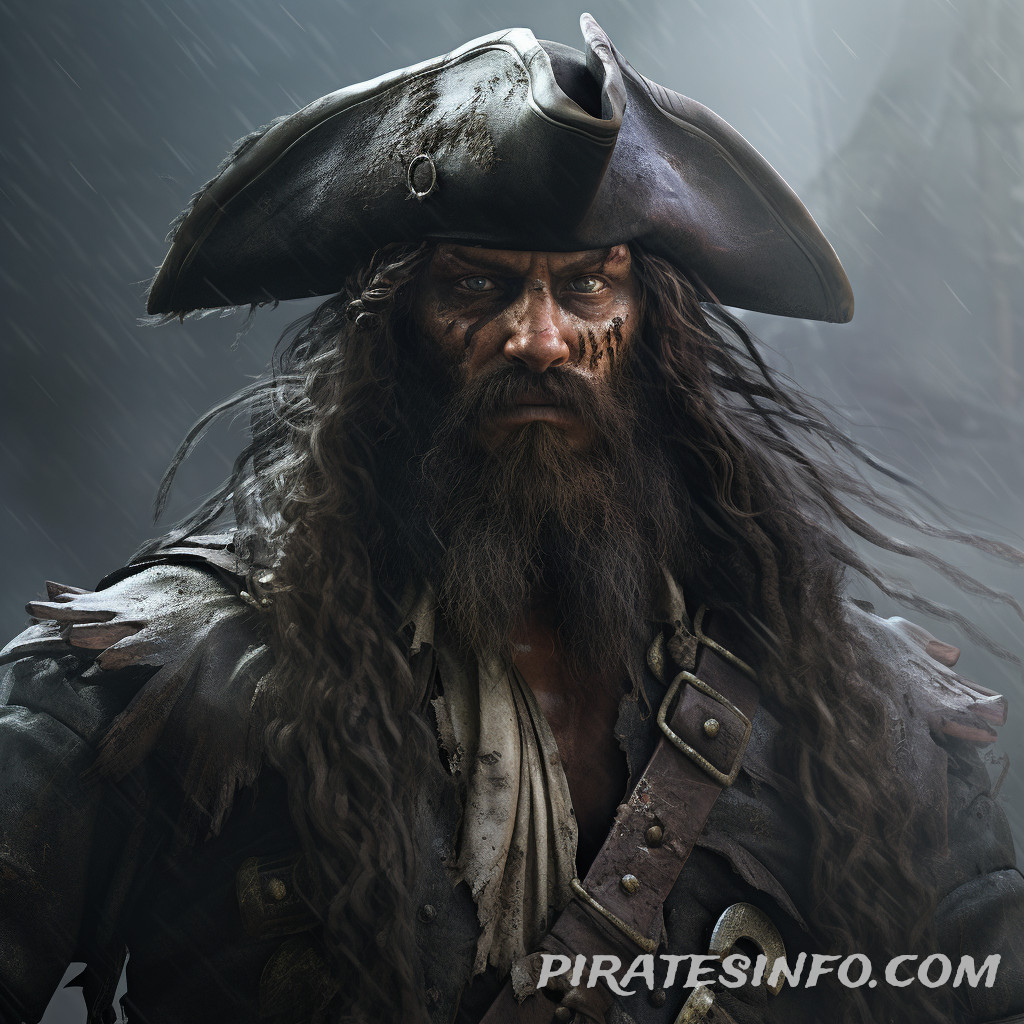
Edward Teach aka Blackbeard
Summary of Blackbeard's life
Fast Facts
-
True Identity: Blackbeard's real name was Edward Teach or Edward Thatch (historical documents vary on the exact spelling).
-
Beard of Terror: He would light slow-burning fuses in his beard during battles, creating an intimidating smoky aura around him.
-
Short-Lived Career: Despite his notoriety, Blackbeard's piratical career lasted a mere 2 years (1716-1718).
-
A Gentleman Pirate: There are no records of Blackbeard killing anyone he held captive.
-
Wreck Discovery: In 1996, a shipwreck was discovered off the coast of North Carolina believed to be Blackbeard’s famed ship, the Queen Anne’s Revenge.
-
Blockade Master: In one of his most audacious acts, Blackbeard once blockaded the port of Charleston, South Carolina, holding the city hostage.
-
End of the Line: Lieutenant Robert Maynard of the Royal Navy killed Blackbeard in a fierce battle near Ocracoke Island, North Carolina.
-
A Gruesome Trophy: After his death, Blackbeard’s head was hung from the bowsprit of Maynard's ship as a warning to other pirates.
-
Pirate Sympathizers: Blackbeard often frequented the town of Bath, North Carolina, where he was said to have friends and allies.
-
Marital Mystery: According to legend, Blackbeard had 14 wives, though this claim is hard to verify with historical evidence.
In the annals of pirate lore, few names stand out quite as distinctly as that of Blackbeard. While most pirates had their fleeting moments of notoriety, Blackbeard's infamy has endured through the ages, not merely for his ruthlessness but for his flair for theatrics and his impeccable sense of timing.
Born Edward Teach (or perhaps Thatch - historical records can't quite decide), this maritime terror took to the seas in the early 18th century. If legends are to be believed, Teach wasn’t just any run-of-the-mill pirate. No, this man was the rock star of the pirating world! Imagine the silhouettes of ships against a setting sun, sails billowing, and at the helm, a man with smoking fuses woven into his beard, creating a halo of smoke and fire around his head. That's right, Edward Teach didn't just accept the moniker "Blackbeard" because of some dark facial hair; he embraced it with a drama that would've made Shakespeare tip his hat.
Now, when Blackbeard wasn't making his enemies believe he was the devil incarnate, he was busy being a shrewd tactician. He blockaded the port of Charleston for ransom and navigated his ship, the formidable 'Queen Anne's Revenge', through the treacherous shoals of North Carolina. His choice of that specific ship tells us something too. Naming your ship after a recently dethroned queen? Now that's a political statement, and quite the audacious one!
You might ask, why North Carolina? Well, it wasn’t just for the views. The intricate inlets of the Carolina coast were the perfect hideaway for pirates, and Blackbeard was no stranger to using the land to his advantage. On the shores of what's now known as Beaufort Inlet, divers have discovered the wrecked remains of what many believe to be the Queen Anne's Revenge. Amidst the sunken cannons and barnacle-encrusted anchors, there's a tangible connection to the world Blackbeard once ruled.
But like all good things, Blackbeard's reign couldn't last forever. His final act took place at Ocracoke Inlet, where Lieutenant Robert Maynard, with orders to end the pirate threat, engaged him in fierce hand-to-hand combat. As the tale goes, Blackbeard received twenty slashes and five gunshot wounds before he finally fell. And even in death, he didn't lose his flair. Rumor has it that when Maynard beheaded him and suspended his head from the ship's bow, Blackbeard's body swam around the ship multiple times before sinking into the depths. Talk about leaving an impression!
Today, the legend of Blackbeard continues to inspire tales of adventure, treachery, and high-sea heroics. Though he lived for only a short 38 years, his legacy remains as undying as the myths that surround him. So, the next time you hear the whisper of waves or spot a ship on the horizon, spare a thought for Edward Teach, the enigmatic force of nature, the phantom of the seas, the man known as Blackbeard.
Had a taste of the pirate life on this page? Ready for the full feast? Set sail to our pirates website for a banquet of buccaneering tales!
Full Name: Edward Teach or Edward Thatch (exact spelling varies across historical documents).
Known Aliases or Nicknames: Blackbeard, Black Beard.
Birth Date: Circa 1680.
Death Date: November 22, 1718.
Place of Birth: The exact place remains debated. Some suggest he was born in Bristol, England, while others argue for various locations in the Caribbean.
Type of Pirate: He was a true pirate, not a privateer. Blackbeard turned to piracy after serving as a privateer during Queen Anne's War.
Areas of Operation: Primarily the American eastern seaboard, especially around the West Indies, the American colonies, and the Bay of Honduras.
Physical Description: Blackbeard was a tall man with a long, thick black beard that almost covered his whole face. He's famously known for putting slow-burning fuses in his beard and lighting them during battles, giving him a devilish appearance amidst the smoke. Exact details on eye color, tattoos, or other features are lost to history, but his beard was his most notable feature.
Flag/Emblem: Blackbeard's flag depicted a horned skeleton raising a toast while spearing a heart, with a border of bones on either side. This was to symbolize his ferocity and to strike fear into the hearts of those who saw it.
While much of Blackbeard's life is shrouded in myth and legend, his legacy as one of the most feared and notorious pirates in history remains indisputable.